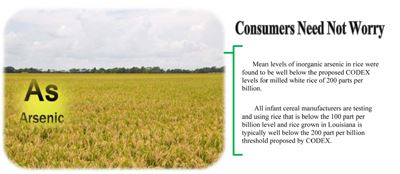|
Is Arsenic In Rice An Issue?
DR. STEVE LINSCOMBE AND DR. DUSTIN HARRELL
RAYNE, LA.
On April 1, the U.S. Food and Drug Administration updated the Arsenic in Rice webpage to include a draft Risk Assessment with a draft action level for infant rice cereal that suggests an inorganic arsenic level not to exceed 100 parts per billion and also suggests that pregnant women and infants eat a well-balanced diet that includes rice as well as other grains.
The information below was prepared by Dr. Samuel M. Cohen, who is a renowned professor in the Department of Pathology and Microbiology at the University of Nebraska.
Arsenic is a ubiquitous natural substance that occurs in several forms. In water it is present mostly as inorganic arsenic, which is the form that has been associated with certain health effects when present at high levels. In foods, including rice, arsenic is present in the inorganic form and in various organic forms. Organic forms of arsenic do not pose a toxic risk for humans. Extensive studies in humans, animals, and in cells show that inorganic arsenic causes toxicity only when consumed at very high levels. Exposure to inorganic arsenic at levels we see in the United States pose no public health risk. Inorganic arsenic is present in rice at levels considerably below any estimated threshold. Supporting a lack of health risk from rice consumption are the results of recent studies funded by the National Institutes of Health (NIH) from the United States, involving more than 200,000 people. Potential risks of cardiovascular disease and cancer risks were evaluated. No effect related to rice consumption was detected, even in individuals, such as Japanese and Chinese, who consumed large amounts of rice every day as a staple of their diet. A similar study was reported from Japan, also showing no health risk. The strong scientific data supporting a threshold effect for inorganic arsenic on health effects combined with extensive epidemiology studies clearly support the safety of rice consumption in the United States, even when consumed daily.
Currently, only the total inorganic arsenic content of foods are associated as contributing to the carcinogen potential or other deleterious health effects caused by consuming excessive arsenic. The CODEX Alimentarius Commission of the World Health Organization and the Food and Agriculture Organization of the United Nations, the body that is tasked with establishing international food standards, recommends a maximum acceptable inorganic arsenic level in polished (milled) rice of 200 parts per billion and a maximum level of inorganic arsenic in husked (brown) rice of 350 parts per billion.
Arsenic and Rice
Arsenic (As) is found naturally in the soil. It can also be found in water and air in trace amounts and is, therefore, naturally absorbed by plants. Arsenic can be found in both organic and inorganic forms. Inorganic forms include arsenite (AsO3-3) and arsenate (AsO4+5), while organic forms include monomethylarsonic acid (MMA) and dimethylarsinic acid (DMA). Consumed organic and inorganic forms of arsenic are typically excreted from the human body in urine after being metabolized by a process called methylation. Inorganic arsenic forms tend to take longer to be metabolized than organic forms and, therefore, reside in the body longer. Only the inorganic forms of arsenic in foods are associated with harmful health effects.
The inorganic arsenate and arsenite forms of arsenic can both be taken up by plants. The arsenate form is more prevalent in upland soils. Under aerobic conditions, arsenate is typically adsorbed onto iron oxide, iron hydroxide and soil surfaces and is typically not very available. Under flooded conditions, the iron is reduced, which releases the arsenate. Subsequently, arsenate is reduced to arsenite and becomes more available for uptake. Arsenate adsorbed to soil surfaces is released much faster under flooded conditions. Soils with increased levels of arsenic have a higher potential to release adsorbed arsenic, which subsequently can be released, reduced and absorbed by plants after submergence.
Aeration of a submerged soil is one way to reduce the availability of arsenic for plant uptake. A recent, yet unpublished, multistate trial funded by the USA Rice Foundation evaluated four different water management practices implementing a range of aeration events during the growing season. The practices included continuous flooding (CF), straighthead management (SH), alternate wetting and drying (AWD) and semi-aerobic (SA). The results of the trials concurred that the aeration events decreased inorganic arsenic levels in rice. Mean levels of inorganic arsenic in rice were found to be well below the proposed CODEX levels for milled white rice of 200 parts per billion. Cadmium levels in rice, however, were increased with rice grown in more upland conditions. Mean rice yields were greatest in CF in almost all trials across years with SA yields obtaining the lowest yields in almost all trials.
Currently, all infant cereal manufacturers are testing and using rice that is below the 100 part per billion level. Rice grown in Louisiana is typically well below the 200 part per billion threshold proposed by CODEX. Consumers need not worry about arsenic in rice. ∆
DR. STEVE LINSCOMBE: Professor and Director, LSU AgCenter
DR. DUSTIN HARRELL: Associate Professor, LSU AgCenter

|
|